When people think of pests they are most often referring to creepy crawlers that can be found lurking inside their home. The majority of pests, however, rarely make it into your home and should be of higher concern than those that do since they can damage valuable food sources.
Maintaining a healthy garden on your property is a lot of hard work but well worth it when you get to enjoy all of the fresh produce that comes as a result of all your hard work. It is a shame when all of that hard work and time spent goes to waste due to pests which, if understood properly, can be diminished to have minimal effects on your output.
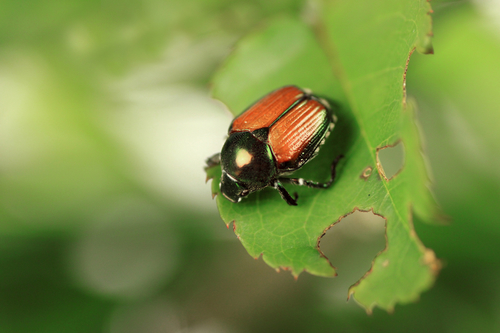
There are a large variety of garden pests in Ontario that can negatively affect your garden in a multitude of ways. This article will explore some of the more common garden pests found in Ontario, examining early warning signs of their presence, how to distinguish one pest from the next, how to get rid of them in an environmentally friendly way and how to protect your beautiful garden from being destroyed by unwanted pests. If you are having trouble getting rid of a problematic pest it is highly recommended to contact a professional pest control operator such as www.pestendmississauga.ca who should be able to assist with your concerns.
Aphids
Warning signs that you have Aphids in your garden
One of the most common pests that are found in gardens across Ontario are aphids. There are over 4,000 aphid species around the world, each feeding on the sap of various plants. Plants become weaker when aphids are present for two reasons; aphid saliva is toxic to plants and the removal of sap diminished the plants health. Here are some early warning signs that aphids are present in your garden:
- slower growth rate of plants
- stunted plant growth
- curled leaves
- browning and wilting of plants
- plant death in extreme cases
Physical appearance
Aphids are very small insects with a body length of 1mm upto 10mm for larger species. They have a soft pear shaped body with antennae at the tip of their head and can be a variety of colours, most commonly green, brown, yellow, red or black. Most aphids are wingless, however, there are some that develop wings.
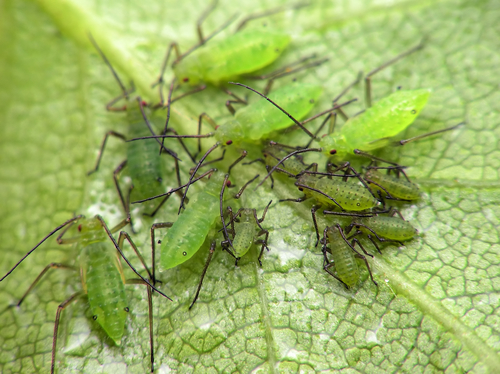
How to get rid of Aphids
If you come across these pests in your garden there are several options for controlling the infestation to avoid having them kill diminish the health and livelihood of your garden such as:
- Removing heavily infested plant parts
- Hosing down infested plants with a powerful stream of water. Make sure that the pressure isn’t so high that it damages the plant itself
- Use beneficial pests which are natural predators of aphids, such as ladybugs, to fight off the infestation. This only works when the infestation is still relatively small.
Slugs
Warning signs that you have Slugs in your garden
In an Organic Pest Control Survey conducted by Mother Earth News back in 2010, slugs were reported to be the most troublesome pest found in home gardens. Most slug species are not a direct threat to home gardens, however, the few species that are a threat can diminish the health of your garden very quickly by eating and destroying fruit and vegetable plants. Since slugs mainly come out at night and hide in shady areas during the day it is unlikely that you will see them unless you are looking for them. Some early warning that you may have slugs present in your garden include:
- Large holes in foliage
- Damage to seedlings and low growing plants
- Holes in ripening fruits and vegetables
Physical appearance
Slugs have a soft and long slimy looking body which pretty much resembles a snail without it’s shell. They can be anywhere from a quarter inch to three inches in length and are usually brown or grey in colour. At the tip of their head they have 3 retracting tentacles, two of which are used for seeing and the third which is used for sensing their surroundings. As they move around they secrete a slimy mucus to glide their body on.
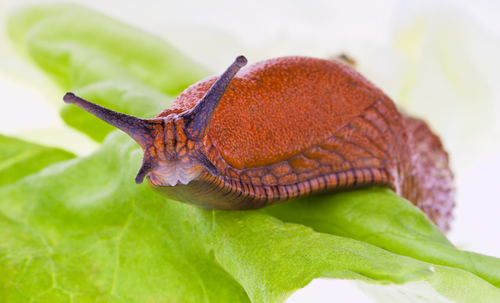
How to get rid of Slugs
Since slugs most often come out at night, it may be difficult to know you have them in your garden unless if you see some clear warning signs listed above. If you believe you have slugs in your garden, follow these tips to get rid of this pest:
- Hand picking them out of your garden when they appear after sunset
- Trapping them with strips of cardboard, plywood and cabbage leaves placed strategically around your garden
- Placing shallow cups of beer around your garden will attract and drown the pests
- Using natural predators such as chickens and ducks who love feeding on these slimy pests
Squash Bugs
Warning signs that you have Squash Bugs in your garden
Squash bugs can be a nuisance to anyone who has cucurbit vegetables in their garden such as squash, pumpkins, zucchinis and cucumbers. Detecting them early on is crucial as they populate very quickly and before you know it can damage a large portion of your cucurbit crop. As these pests feed on the sap of foliage and vines from your plants they inject a toxic substance into the plant causing it to wilt and, often times, die. Some signs that these pests have infested your garden are:
- Wilted, yellowing or dead leaves on your cucurbit plants
- Finding a collection of small black bullet shaped eggs on the bottom of leaves near the stem
Physical Appearance
Adult squash bugs are less than an inch in length and are typically dark brown or grey in colour. They have 6 legs and a shield shaped hard shelled body with two antennae sticking out from their head. They also have wings on their back and a straw like mouthpart used for sucking sap out of plants. Nymph squash bugs are quite different in appearance and look like tiny spiders approximately 1/10 of an inch in length.
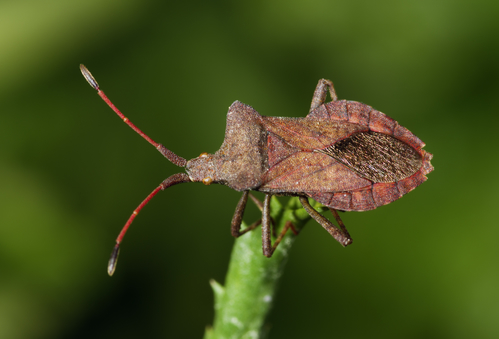
How to get rid of Squash Bugs
Due to their colour, squash bugs easily go unnoticed when they are in your garden. To find these pests you have to make an effort to look for them on the underside of leaves. If you do find them lingering around, try these methods to get rid of them:
- Handpick them and their eggs from the underside of foliage if the infestation is small. Do this on a daily basis as these pests populate very quickly.
- Place shingles or boards near cucurbit plants in the evening which makes an ideal resting spot for them during the night. The following morning, remove these traps and kill all squash bugs and nymphs.
- Remove any damaged plants and their vines, especially at the end of the season to make sure they don’t have a solid base the following season.
Tomato Hornworm
Warning signs that you have Tomato Hornworms in your garden
The tomato hornworm is a large caterpillar known to be one of the most detrimental pests to tomato, eggplant, pepper and potato plants. Due to their bright green colour and their tendency to hide on plant stems, it can be very difficult to spot one of these pests with the naked eye. They are most prevalent in mid to late summer so if you see any of the following damage to the plants listed above during this time of year you may have a tomato hornworm infestation:
- Tomato, eggplant, pepper and potato plant leaves being completely consumed
- Bite marks on small stems from these plants
- Dark green droppings present on the top of leaves for these vegetables
Physical Appearance
Tomato hornworms are most likely the largest caterpillar that you would find in your garden. They range from 3 to 5 inches in length and are a bright green colour, camouflaging with the greenery in your garden. Along their body they have 7 white stripes that run diagonally and a black or red horn-like protrusion at the rear side of their body. They eventually turn into large moths, however, it is the caterpillar stage that is most detrimental to your vegetables.
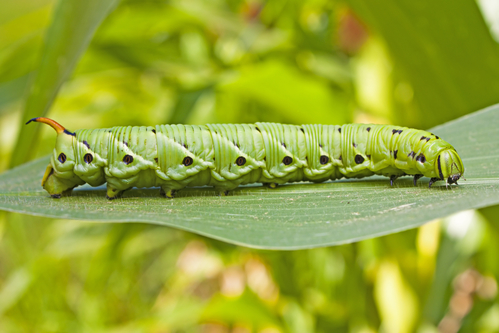
How to get rid of Tomato Hornworms
Although they are one of the largest garden pests found in Ontario, you likely won’t notice that they are present unless you see some of the warning signs listed above. Once you have determined that you have tomato hornworms in your garden take these tips into consideration for getting rid of them:
- Look for them closely under leaves and handpick them. Once you have removed them from your garden, put them in a bowl of water and soap to kill them
- Till the soil in your garden before and after the gardening season to destroy the larvae which are usually laid at the surface of the soil.
- Keep beneficial pests around such as wasps and ladybugs who feed on tomato hornworms and their larvae.
Grasshoppers
Warning signs that you have Grasshoppers in your garden
Grasshoppers can be a serious problem for your home garden and even for farmers if populations are large enough. They consume approximately half of their body weight per day feeding primarily on plant foliage. They also chew on plant stems causing even further damage to the plant health which can potentially kill off your entire garden in a short amount of time. Here are some signs that you may have these pests feeding in your garden:
- Damaged leaves from bite marks, usually around the edges of the leaves
- Bite marks on the stems of your garden vegetables
Physical Appearance
Their body length is anywhere from 1 to 2 inches in length and can be a variety of colours including brown, green or a reddish yellow mix. They have scissor like jaws used for chewing up plants and short antennae at the tip of their head. They also have large and powerful hind legs used for jumping long distances and fully developed wings which helps them glide even further.
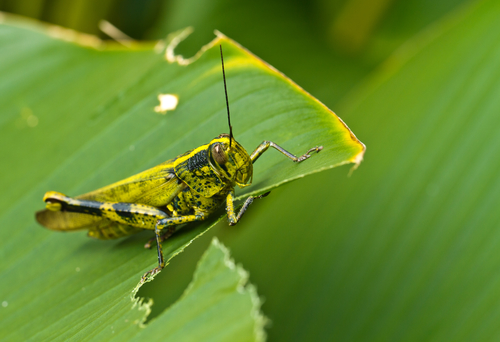
How to get rid of Grasshoppers
As mentioned above, grasshoppers can be a serious problem if their population gets out of control. According to the USDA, 10 grasshoppers per square yard can be economically damaging to a farmer. If their population really gets out of control they are considered locusts and can destroy hundreds of acres of farmland per day; this of course is a rare occurrence. In any case, be sure to keep an eye out for these pests and follow some of these tips to keep their populations at a controllable size:
- Use row covers to protect your garden from intruders
- Roto-till your soil in the spring to kill off any eggs that were laid before the winter
How to Protect Your Garden From Unwanted Pests
The pests listed above are just some of the common critters that you may find in your garden if living in Ontario. There are many more pests that can cause harm to your fruits and vegetables so the best measure to keep them away is to use preventative measures that will work for a multitude of detrimental insects. Here are some quick tips to make your garden pest proof:
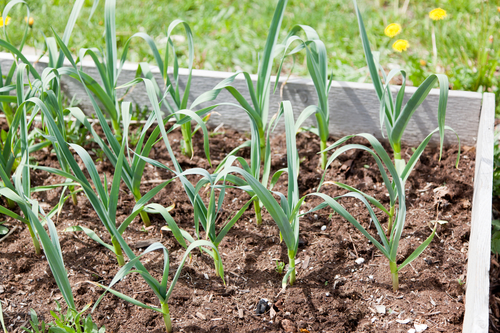
- Mix pest deterring plants into your garden – By also placing a few plants with strong odours, such as garlic and onion, pests will not be able to find the plants they love to destroy due to the overpowering smell.
- Rotate your crops from one season to the next – By moving your plants from one garden to another each season, pests from the previous season will have a more difficult time finding their food source resulting in many of them dying off or leaving in search for an easier foor source.
- Use spices to deter pests – A home made pest deterrent it to mix strong spices, such as tabasco sauce, with water and spraying it into your soil and over your plants and vegetables. This will deter all types of pests from nibbling away at your garden, including wildlife as well.